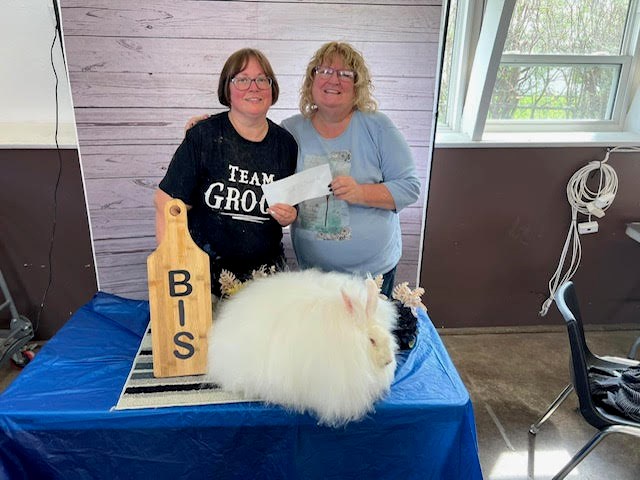And the award for the fluffiest and most adorable animal in the world goes to the Angora rabbit.
One of the oldest breeds of domestic rabbits, Angoras are known for their soft furry coats.
Julie Martin from Smokey Hollow Farm in Hillsburgh has been breeding Angora rabbits for over 40 years. A number of them have won numerous awards and shows in both Canada and in the U.S.
“I’ve raised rabbits since I was five years old. And just last year, I started Smokey Hollow Farm,” Martin said.
Besides raising and breeding rabbits, Smokey Hollow Farm in Hillburgh, offers hand spun yarns, a variety of Angora yarns plus other blends, and fibres in natural and hand dyed colours.
Martin also offers finished hand knit, crochet garments and photo art.
“My previous job was in television, so I really enjoy taking photos. And we also grow Seabuckthorn berries on the farm,” Martin said.
However, Martin says, Smokey Hollow Farm is not an ‘experience’ farm.
“We are not set up for visitors, and we do not sell rabbits. It's still a new venture. Before this, I ran Smokey Hollow Rabbitry, where I raised English Angoras primarily,” Martin said.
Two years ago, Martin introduced French Angora rabbits to her farm.
“I have a friend, Sue Needle, who raises the best French Angoras. So now, I have both,” Martin said.
“English Angoras are the smallest breed of Angora rabbits. They have wool everywhere, including on their ears, face, cheeks, and feet,” Martin said.
“A French angora looks very much like a normal rabbit but with a very woolly body. And they are much bigger.”
Angora rabbits produce a very soft wool that can be spun into yarn or felted for craft projects.
“I have all of this luxurious wool that I’ve been collecting. So, I have learned how to spin, and now I offer the wool for sale,” Martin said.
“I sell the wool, hand spun yarn, fibre, and some finished goods as well. There’s only a hand full of us that do this in Ontario, where we raise the Angora rabbits and sell the wool.”
Martin says the art of spinning wool is making a comeback.
“I hope to join the Guelph Spinners and Weavers Guild. And I would like to learn how to weave down the road. I have the looms. Now, I just have to learn.”
Angora fibre from rabbits is lightweight and often warmer than sheep’s wool.
The hypoallergenic nature makes it a perfect fabric for people who suffer from asthma and allergies.
“Angora is also good for people who have arthritis and for warmth. It is nine times warmer than sheep's wool and it’s not itchy. Sheep’s wool can sometimes be quite course,” Martin said.
What Martin says she loves most about raising rabbits, is competing.
“I used to be a figure skater, so I enjoy the competition aspect of showing my rabbits,” Martin said.
“I mainly do market fibre shows right now. We are at the local fairs, and show the rabbits there,” Martin said.
Martin is a member of various organizations including the American Rabbit Breeder’s Association, National Angora Rabbit Breeder’s Club, and the Southern Ontario Rabbit Breeder's Association.
“We are at lot of the fall fairs and even shows in the U.S., Martin said.
Her French angora rabbit, Mags, who weighs between eight to 10 pounds, is a prize-winning rabbit and has won numerous awards.
“The French angora is typically larger than the others. Mags was born from the first litter at my farm. There were only three. One passed away, so there only two in the end. They were both does, and they were both white. They looked exactly the same,” Martin said.
“Mags was supposed to go to my friend Sue, but when she was little, she broke her leg. We think it was from jumping off of her mom’s back."
But Mags healed and went on to win six ‘best in’ shows in the spring.
“Her sister ended up chipping a tooth, so Mags took the top prize. The two sisters are yet to compete against each other,” Martin said.
There are many different Angora breeds. Martin says Satin angoras have shinier coats.
“The hair in the wool has a natural sheen to it. And Giant angoras look much like English angora rabbits, but they are a lot larger and have a different coat base,” Martin said.
“The German angora is primarily a commercial breed. You don’t’ really see them showing that much. They are usually white and used for commercial wool.”
Martin says there are different methods when it comes to removing wool from rabbits, whether it’s brushing, clipping or sheering.
‘Or you can wait until they moult. When they do moult, the coat releases the wool and you can just pluck it out of the rabbits. It doesn’t hurt them. You can actually sit the rabbit down, and spin directly from the rabbit when that happens.”
Martin has 32 cages at Smokey Hollow Farms, but not all the rabbits are Angoras.
“I have Champagne d'Argent rabbits, which are a heritage meat breed, but I don’t raise them for meat. I just raise them for show,” she said.
Martin says her Polish rabbits are small, dwarf like rabbits, with a calm temperament, considered to be the ‘aristocrats’ or ‘royalty’ in the rabbit world.
“The English Angoras, they are the clowns. They just make you laugh,” Martin said.
“Rabbits are like any other kind of animal. They all have their own personality with different characteristics. And each one is so unique.”
For more information, visit https://smokeyhollowfarms.ca/.



